Introduction
Introduction to Active Filters
-
Filters process signals by passing selected frequencies while rejecting others
-
Active filters use op-amps with passive RC circuits
-
Filters categorized by output voltage variation with input frequency
-
Four basic categories:
-
Low-pass
-
High-pass
-
Band-pass
-
Band-stop
-
-
Advantages over passive filters:
-
Gain provided by active elements
-
High input impedance
-
Low output impedance
-
Filter Responses
Low-Pass Filter Response
-
Passes frequencies from DC to critical frequency \(f_c\), attenuates others
-
Passband: Frequencies with \(< -3 \, \text{dB}\) attenuation
-
Critical frequency: \(f_c = \dfrac{1}{2 \pi R C}\) (single-pole \(RC\) filter)
-
Roll-off: \(-20 \, \text{dB/decade}\) per pole
-
Bandwidth: \(BW = f_c\) (ideal)

High-Pass Filter Response
-
Passes frequencies above \(f_c\), attenuates below
-
Critical frequency: \(f_c = \dfrac{1}{2 \pi R C}\) (single-pole \(RC\) filter)
-
Roll-off: \(-20 \, \text{dB/decade}\) per pole
-
Practical limitation: Op-amp’s internal \(RC\) circuits limit high-frequency response

Band-Pass Filter Response
-
Passes frequencies between lower (\(f_{c1}\)) and upper (\(f_{c2}\)) critical frequencies
-
Bandwidth: \(BW = f_{c2} - f_{c1}\)
-
Center frequency: \(f_0 = \sqrt{f_{c1} f_{c2}}\)
-
Quality factor: \(Q = \dfrac{f_0}{BW} = \dfrac{1}{DF}\) (DF: Damping factor)
-
\(Q > 10\): Narrow-band; \(Q < 10\): Wide-band
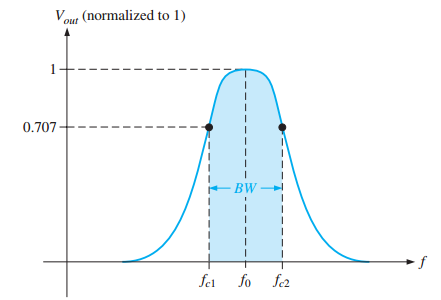
Band-Stop Filter Response
-
Rejects frequencies between \(f_{c1}\) and \(f_{c2}\), passes others
-
Bandwidth: \(BW = f_{c2} - f_{c1}\)
-
Opposite of band-pass filter
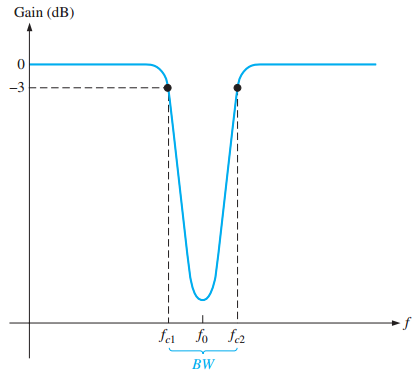
Filter Characteristics
Filter Response Characteristics
-
Butterworth: Flat passband, \(-20 \, \text{dB/decade/pole}\), nonlinear phase
-
Chebyshev: Steeper roll-off (\(> -20 \, \text{dB/decade/pole}\)), passband ripples
-
Bessel: Linear phase, minimal overshoot, suitable for pulse waveforms
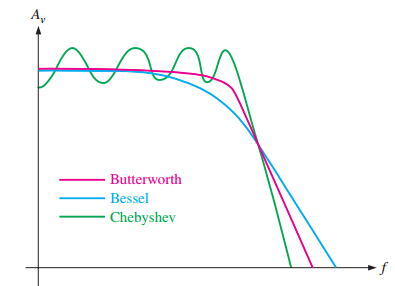
Damping Factor
-
Determines response characteristic
-
Defined as: \(DF = 2 - \dfrac{R_1}{R_2}\)
-
Example: For second-order Butterworth, \(DF = 1.414\), so \(\dfrac{R_1}{R_2} = 0.586\)

Critical Frequency and Filter Order
Critical Frequency (\(f_c\)) for first-order RC filter: \[f_c = \frac{1}{2\pi RC}\]
Applies to both low-pass and high-pass single-pole configurations
-
Roll-Off Rate:
-
Butterworth filter: \(-20\, \text{dB/decade/pole}\)
-
1st-order (1 pole): \(-20\, \text{dB/decade}\)
-
2nd-order (2 poles): \(-40\, \text{dB/decade}\)
-
3rd-order (3 poles): \(-60\, \text{dB/decade}\), etc.
-
Filter Implementations
Single-Pole Low-Pass Filter
-
Uses one \(RC\) circuit, roll-off \(-20 \, \text{dB/decade}\)
-
Critical frequency: \(f_c = \dfrac{1}{2 \pi R C}\)
-
Gain: \(A_{cl(NI)} = \dfrac{R_1}{R_2} + 1\)
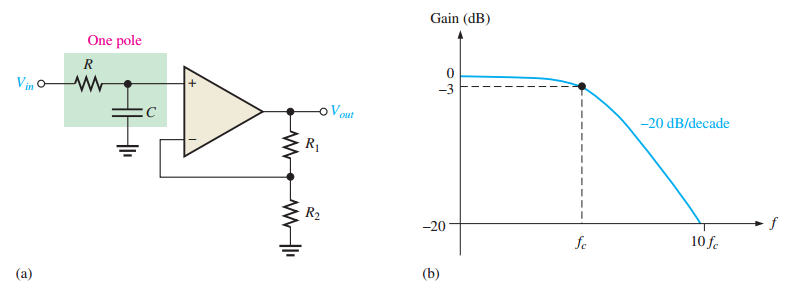
Sallen-Key Low-Pass Filter
-
Common second-order configuration (VCVS)
-
Two-pole filter, roll-off \(-40 \, \text{dB/decade}\)
-
Critical frequency: \(f_c = \dfrac{1}{2 \pi \sqrt{R_A R_B C_A C_B}}\)
-
If \(R_A = R_B = R\), \(C_A = C_B = C\): \(f_c = \dfrac{1}{2 \pi R C}\)
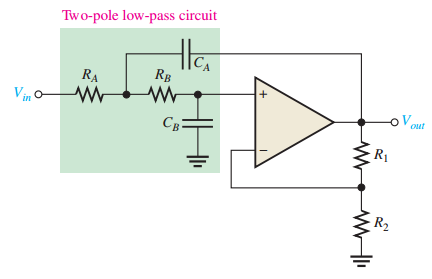
Cascaded Low-Pass Filters
-
Third-order: Cascade 2-pole Sallen-Key + 1-pole filter (\(-60 \, \text{dB/decade}\))
-
Fourth-order: Cascade two 2-pole Sallen-Key filters (\(-80 \, \text{dB/decade}\))
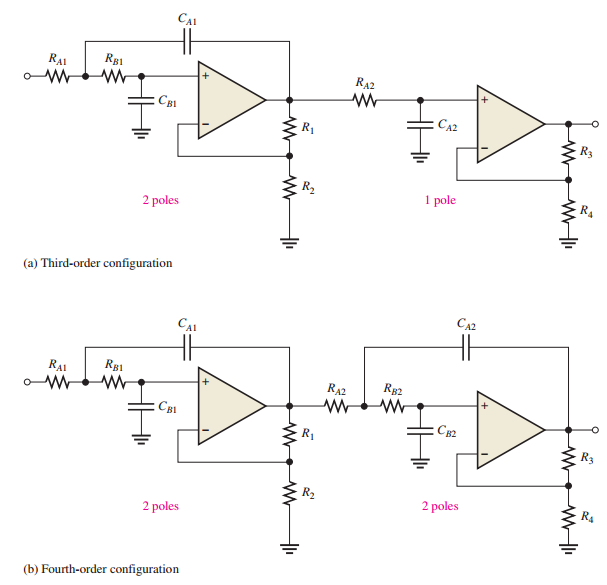
Single-Pole High-Pass Filter
-
Roll-off: \(-20 \, \text{dB/decade}\)
-
Critical frequency: \(f_c = \dfrac{1}{2 \pi R C}\)
-
Limitation: Op-amp’s internal \(RC\) limits high-frequency response
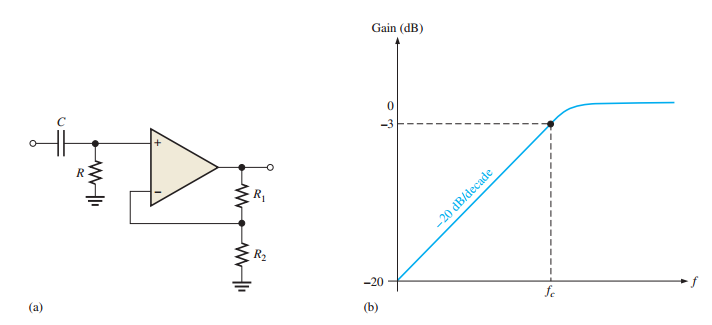
Sallen-Key High-Pass Filter
-
Two-pole filter, roll-off \(-40 \, \text{dB/decade}\)
-
\(R\) and \(C\) positions swapped compared to low-pass
-
Response optimized by feedback resistors \(R_1\), \(R_2\)
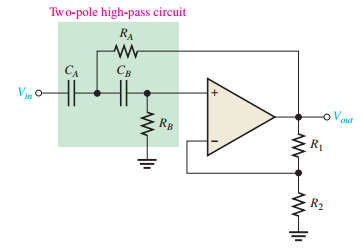
Band-Pass and Band-Stop Filters
Cascaded Band-Pass Filter
-
Cascade high-pass and low-pass Sallen-Key filters
-
\(f_{c1} = \dfrac{1}{2 \pi \sqrt{R_{A1} R_{B1} C_{A1} C_{B1}}}\)
-
\(f_{c2} = \dfrac{1}{2 \pi \sqrt{R_{A2} R_{B2} C_{A2} C_{B2}}}\)
-
Center frequency: \(f_0 = \sqrt{f_{c1} f_{c2}}\)
-
Suitable for wide bandwidth applications
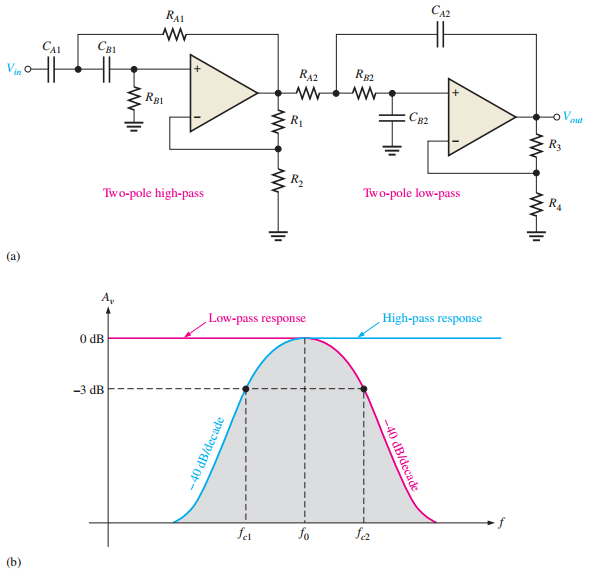
Multiple-Feedback Band-Pass Filter
-
Center frequency: \(f_0 = \dfrac{1}{2 \pi C \sqrt{\dfrac{R_1 + R_3}{R_1 R_2 R_3}}}\)
-
Gain: \(A_0 = \dfrac{R_2}{2 R_1}\)
-
Resistors:
-
\(R_1 = \dfrac{Q}{2 \pi f_0 C A_0}\)
-
\(R_2 = \dfrac{Q}{\pi f_0 C}\)
-
\(R_3 = \dfrac{Q}{2 \pi f_0 C (2 Q^2 - A_0)}\)
-
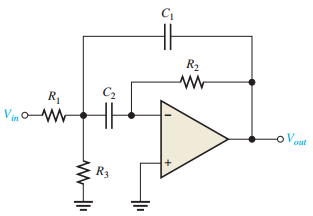
State-Variable Filter
-
Uses summing amplifier and two integrators
-
Center frequency: \(f_0 \approx \dfrac{1}{2 \pi R C}\)
-
\(Q = \dfrac{1}{3} \left( \dfrac{R_5}{R_6} + 1 \right)\)
-
Provides low-pass, high-pass, band-pass outputs

Biquad Filter
-
Integrator, inverting amplifier, integrator
-
Provides band-pass and low-pass outputs
-
High \(Q\), bandwidth independent of \(f_0\)

Multiple-Feedback Band-Stop Filter
-
Similar to band-pass, with modified resistor configuration

State-Variable Band-Stop Filter
-
Created by summing LP and HP outputs
-
Common application: 60 Hz noise rejection
-
Center frequency set by integrator RC circuits
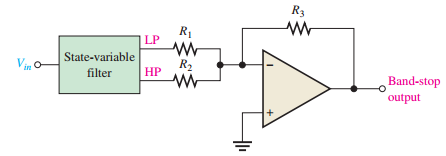
Measurements
Filter Response Measurements
Discrete Point Measurement
-
Set constant input amplitude
-
Sweep frequency in steps
-
Record output at each frequency
-
Plot response curve
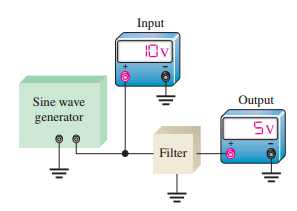
Swept Frequency Measurement
-
More efficient than discrete method
-
Uses swept frequency generator
-
Display options:
-
Spectrum analyzer
-
Oscilloscope in X-Y mode
-
-
Provides continuous response curve

Summary
-
Covered low-pass, high-pass, band-pass, band-stop filters
-
Discussed Butterworth, Chebyshev, Bessel characteristics
-
Analyzed single-pole, Sallen-Key, multiple-feedback, state-variable, biquad filters
-
Explained damping factor, critical frequency, roll-off rates
-
Described discrete point and swept frequency measurements